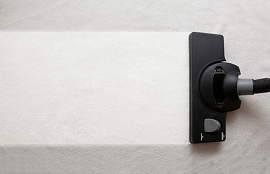Whether you’re allergic to pet dander, tree pollen or ragweed, the coughing, sneezing, itching, and sniffling can really start to get you down. While your first thought may be to reach for your antihistamines, you may want to first look at your indoor air quality. Research suggests that indoor air can be packed with allergens, but fortunately, there are some simple ways to improve your air quality to help you breathe easier.
Fit HEPA Filters to Your Vacuum
If you suffer from allergies, you’re likely to be aware of the importance of regular vacuuming. Unfortunately, your vacuum cleaner may be powerful, but it may not offer the best allergen protection unless it is fitted with a HEPA filter. HEPA filters can trap even the smallest dust mites up to 3 micron in size. This will help you to keep all your flooring and hard surfaces free of allergens.
Use A Room Air Cleaner
Air cleaners also use HEPA filters to clear allergens from your air. If you have pets, you should run your air cleaner in the area where they spend the most time. It should also be used in the room where you sleep. This will reduce the allergens in your air by as much as 50 percent to make the air easier to breathe.
Control Your Humidity
Dust mites thrive in humid conditions and the more people and humidity in an area, the greater number of dust mites. These little mites live throughout the year, so you need to watch out for them even outside of allergy season. A dehumidifier can help to reduce your home’s humidity levels to create a less favorable environment for the mites. Experts recommend a humidity level below 50 percent to minimize mites and reduce the risk of mold developing inside your home. Remember to empty and clean your dehumidifier regularly, to avoid the appliance creating a damp environment that may encourage mildew and mold.
Use a Hot Wash For Linens
Dust mites and other allergens can thrive in mattresses and other bedding. Fortunately, you can combat this with a hot wash. Washing your linens and clothing in hot water helps to remove allergens including pollen that you bring inside from outdoors. Allergens can easily detach from soft furnishings and become airborne again, creating air quality issues. Ensure that your bedding is washed regularly and don’t neglect drapes and other soft furnishings to ensure that they are free of mites and other allergens.
Sanitize Your Dishwasher
While this isn’t strictly related to seasonal allergies, if you are sensitive to allergies it is a good idea to sanitize your dishwasher. Food particles and other debris can accumulate inside your dishwasher, creating a problem for those with sensitivities or food allergies. Most dishwashers have a sanitize cycle, but if not run your dishwasher on a hot cycle with a dish of white vinegar in the lower rack. This will disinfect the inside compartment and make it sparkling clean.
Change Your HVAC Filters
Finally, ensure that you change your HVAC filters regularly. Clogged filters lose their ability to trap allergens and allow particles to re-enter the air. Most manufacturers recommend changing filters each month during periods of heavy use, but ensure that you use a HEPA filter to keep your air free of allergens.
